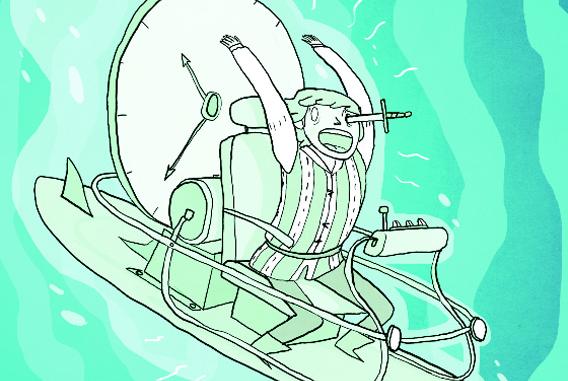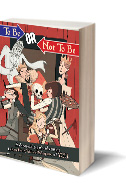
Slate is an Amazon affiliate and may receive a commission from purchases you make through our links.
Outrageous Fortune
A self-published riff on Hamlet broke every Kickstarter record. But is this book worth $580,905?

Illustration by Noelle Stevenson from To Be or Not to Be
Late last year, Web cartoonist Ryan North launched a Kickstarter campaign to fund To Be or Not to Be, an illustrated “chooseable-path adventure”—pardon the copyright dodge—version of Hamlet. Thanks to media attention and a viral spread that attracted an audience beyond fans of North’s popular Dinosaur Comics, it became the most funded publishing project in Kickstarter history, surpassing its initial $20,000 goal by more than half a million dollars. (It has since been beaten, barely, by a Planet Money campaign to fund a T-shirt picturing a squirrel drinking a martini.)
North’s campaign was very close to perfect, one that should serve as inspiration to anyone who wants to crowdfund a creative project: The concept was innovative; the reward tiers were thoughtfully designed; North communicated clearly and enthusiastically with backers at every step of the process; and the project not only delivered what was promised but improved upon the initial concept. As the book arrives in backers’ mailboxes this month, it’s worth asking: Is it a good book? Is it $580,905 good?
North certainly worked hard to make the campaign live up to every penny its backers spent. Kickstarter has no rules about what’s done with money raised in excess of a project’s initial goal, but rather than just sit on his extra cash, North began adding increasingly elaborate stretch goals to improve the book itself, as well as padding existing reward tiers with bonus goodies, and earmarking copies of the book for donation to schools and libraries. The book got full-color illustrations for each one of 110 death scenes, from a hand-picked roster of artists including Hark! A Vagrant creator Kate Beaton. Donors got a prequel (Poor Yorick), a plush Yorick skull, and a multipronged bookmark to make it easier to backtrack through the text. (In To Be or Not to Be, if not in life, you can decide that killing your stepdad wasn’t such a great idea after all.)
As the project total crept ever higher, North’s promises grew increasingly breathless: When the Kickstarter reached $200,000, he said he’d create a “stage performance where the entire internet votes on what happens next”; at $450,000 he promised to “create a pizza that looks like Hamlet and… eat it?” If the project hit $500,000, North said, he would “literally explode.”
I contributed to the campaign because I admire North’s work and thought the book sounded like fun. But thanks to North’s voluble backer updates and creative reward tiers, being a part of his campaign didn’t feel like simply preordering something, as Kickstarter so often does these days; nor did it have the faint whiff of desperation that often comes with artists asking their friends and family for money. This felt like being a part of the creative process, and having a front-row seat to an artist giddily realizing that his biggest dreams are now possible. In North’s case those dreams just happened to involve dinosaurs, emo cannibal Hamlet, and a botched time-travel experiment that turns a major character into a trout.
It should be clear from the above that To Be or Not to Be ranges far afield of Shakespeare’s original story. The book is nothing if not irreverent, full of jokes and digressions and profoundly silly plot twists. The reader chooses which character she’d like to be—Hamlet, Ophelia, or Hamlet’s dad—and then it’s on to the familiar second-person CYOA format that provides readers such options as “Kill everyone in the royal court!”; “Re-read the book and make some new (maybe even better?) choices”; “Get mad at yourself for being such a screw-up, go back to bed, nap”; or, simply, “PARTY BOAT!! Turn to page 207.”

The language is colloquial, and it’s obvious North spends a lot of time on the Internet—there’s a ton of ALL CAPS and question marks at the end of declarative sentences, which I think are supposed to indicate uncertainty? For all its irreverence, though, To Be or Not to Be’s structure actually engages on a fairly high level with the play’s questions about free will, decision-making, and actions and their consequences.
In Hamlet, the Prince of Denmark has one of the most famous existential crises in literary history, as he ponders aloud whether suicide is worth the risk that whatever happens after death might be even worse than life itself. North’s version puts the being vs. not-being decision square in the reader’s hands, though it turns out choosing “Not to Be: turn to page 17” isn’t much of an adventure at all: It leads to artist Mike Holmes’ illustration of Hamlet chugging from a vial of poison, one pinky lifted genteelly, while Ophelia peeks from behind a curtain. There’s no sign of the terrifying death-nightmares Hamlet’s so worried about; just the words “The End.” But even asking the reader to make the decision highlights how much of the original play—and how much of life itself—revolves around possibly crazy people bumbling through situations they barely understand, possessing a fraction of the information they need to get from one scene to the next.
North provides all of Shakespeare’s actual plot decisions—marked in the book by small Yorick skulls—and then allows the reader to second-guess the Bard by larding the book with hundreds of pages of invented storylines. Pathways involving time-traveling ghosts and flesh-eating princes are goofy and fun, but To Be or Not to Be is at its best when it riffs directly on the original script.
One of the cleverest conceits is North’s treatment of Hamlet’s play-within-a-play, in which Hamlet tests Claudius’ conscience by enlisting a troupe of actors to re-enact his father’s murder. Instead of a play, To Be or Not to Be rabbit-holes into a book-within-a-book, a mini-Choose Your Own Adventure complete with its own cover and copyright page. (“This is a copyright page, my name is Christina Marlow and I totally wrote this and y’all are not allowed to steal it.”) The reader steps into Claudius’ character, while offset text is used to allow Hamlet himself to comment on the reader’s choices, mimicking the scenes from Shakespeare’s version.

Courtesy of Randall North
In another sequence, Hamlet fights off pirates alongside Rosencrantz and Guildenstern—a scene that is only briefly described in the play. “This was a really amazing part of your adventure, Hamlet,” the narrator observes. “You’re sure that, should you ever one day write a book about this story or perhaps a stage production, you’d DEFINITELY include this scene. Why, you’d have to be literally crazy to write a story where you journey to England, get attacked by pirates—actual pirates!—but then just sum up that whole adventure in a single sentence. Hah! That’d be the worst.” Reference mixed with irreverence—that’s what makes To Be or Not to Be so much fun. Not every Kickstarter has to raise half a million dollars or pervert Shakespeare’s legacy in order to be successful, but projects of any scale could take a page from North’s antic, unconventional book.
---
To Be or Not to Be by Ryan North. Self-published.
See all the pieces in this month’s Slate Book Review.
Sign up for the Slate Book Review monthly newsletter.